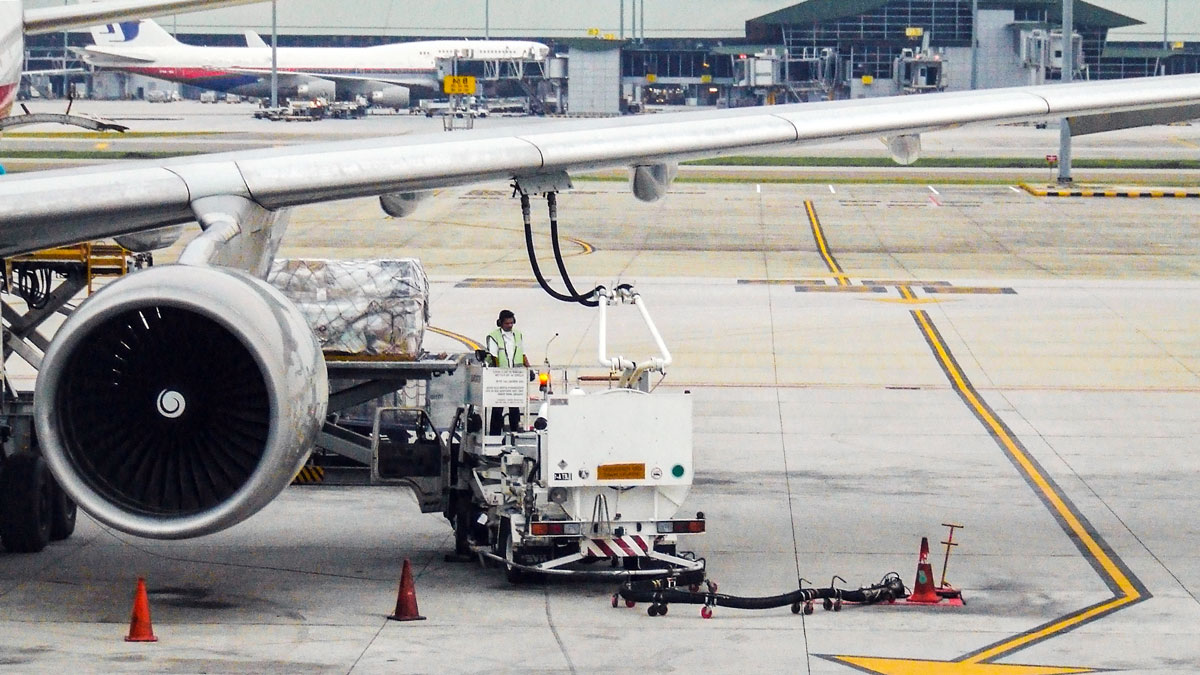Environmental Impact of Aviation Worse than Expected
Moving Towards SAF
The volume of greenhouse gases produced by aircraft is estimated at 1 gigaton (Gt) each year, out of a total of 40 Gt, i.e., 2.5%. This may seem low as relative value, but it contributes to global warming in a different way. The production of cirrus clouds induced by the condensation traces of aircraft (clouds appearing between 5,000 and 14,000 m altitude) contributes with 5% to the global radiation balance of the planet. Air transport is now moving towards SAF (Sustainable Aviation Fuels), alternative fuels produced from biomass, or even synthesized from CO2 and carbon-free electricity, as recent announcements by a group of 60 aviation players show.
Increasing air traffic
20 years ago, there were 2 billion passengers on planes, today there are 4 billion. If we continue at the same pace, 16 billion people will fly by 2050, according to the forecasts of the International Civil Aviation Organization (ICAO). However, even if the energy performance of engines improves, even if certain engines are electric and even if the share of biofuels has increased, this will lead in the best case to a doubling of greenhouse gas production.
In total, aircraft are responsible for 2.5% of CO2 emissions and 5% of total greenhouse gas emissions on the planet, according to Réseau Action Climat association. This percentage may seem low, but it should be seen in perspective. According to experts, the figure varies greatly depending on the calculation methods used. The 2.5% does not take into account stopovers and in reality, the real percentage of greenhouse gas emissions may reach up to 15%.
Due to the record increase in traffic, the significant increase in the number of passengers and trade volume, aviation and international shipping are the fastest growing sources of emissions. Each account for around 3.5% of European Union’s total greenhouse gas emissions. These sectors have only recently been included in CO2 emission reduction efforts, both at European level and globally.
In a resolution adopted before COP25, the European Parliament has asked for more ambition in reducing emissions from aviation and shipping.
Sources with the fastest growth of greenhouse gas emissions
Emissions from international aviation and shipping have increased by almost 130% and 32% respectively over the past 20 years. This is the fastest growth in the entire transport sector, the only one in which emissions have increased since 1990.
By 2050, despite improvement in fuel consumption, it is expected that aircraft emissions will be 7-10 times higher than the 1990 levels, while emissions from ships are expected to increase by 50-250%. Greenhouse gas emissions in aviation and shipping have recorded a significant growth as a result of increased traffic. The number of air passengers in the EU has tripled since the 1990s, and the volume of international maritime trade has also increased significantly over the last two decades.
Environmental concerns could encourage more travellers to be aware of the carbon footprint of their means of transport. According to a survey by Eurobarometer, one in ten Europeans say they take this aspect into account.
Increased traffic remains a ‘non-negotiable’ assumption. Therefore, IATA hopes to double the passenger traffic between 2020 and 2050, which would require 450 billion litres of alternative fuels (65% of decarbonization efforts). However, the biomass and carbon-free electricity source is limited and will face strong competition from other uses (road, rail, sea transport), construction, industry, green chemistry etc. Therefore, there will be a strong supply pressure, exacerbated by the need to use biofuels that meet many sustainability criteria. The way this mechanism is presented is misleading, as carbon ‘offsetting’ and induced emissions are different amounts and cannot be reduced as is currently the case. The aviation sector therefore continues to struggle to escape from the demons of the past… The use of SAF has long been limited to demonstration flights or several well-defined flights (e.g., KLM Los Angeles-Amsterdam flight) and accounts for less than 0.1% of the fuel used. The European Commission has proposed increasing its climate ambition with the Fit for 55 Climate Package, including a mandate to include 2% SAF in 2025 and 5% in 2030. However, with the recent commitment of 60 players in the sector to target 10% SAF by 2030, including some large European companies (British Airways, Iberia, KLM, DHL), the Fit for 55 package has not yet been adopted, so it’s already starting to be obsolete! Thus, the United Kingdom has just announced in its Net Zero Strategy decarbonization plan a mandate to incorporate 10% SAF by 2030.
This enthusiasm for SAF is not only European: among the actors of the announcement are the three major US companies (American Airlines, Delta Airlines, United Airlines).
Shipping included in the EU ETS
The European Parliament recently voted to include shipping in the EU ETS and to set mandatory standards for shipping companies to reduce their CO2 emissions by at least 40% by 2030.
According to MEPs, the Commission’s initial proposal to revise the rules on controlling CO2 emissions from large ships to bring them into line with global rules was not ambitious enough, given the urgent need to decarbonize all sectors of the economy.
The European Parliament reiterated the need to drastically reduce emissions from the shipping industry and include it in EU ETS, highlighting the importance of assessing impact on competitiveness, employment and warned on the potential risk of carbon emission relocation.
Measures to help the shipping sector become cleaner and more efficient under the European Green Deal
- Gradual elimination of heavy fuel oil with tax-exemption compensation for alternative fuels
- Decarbonization, digitization and automation of European ports
- Regulated access to EU ports for the most polluting ships
What is the EU doing to reduce CO2 emissions from aviation?
Through its Emissions Trading Scheme (EU ETS), the European Union has taken steps to reduce emissions from air transport. The EU is also working with the International Civil Aviation Organization to implement a market-based measure called Corsia, which allows airlines to offset their emissions by investing in green projects such as planting trees.
ICAO has developed a methodology to calculate the carbon dioxide emissions from air travel for use in offset programs.
The ICAO Carbon Emissions Calculator allows passengers to estimate the emissions attributed to their air travel. The methodology applies the best publicly available industry data to account for various factors such as aircraft types, route specific data, passenger load factors and cargo carried.
Steps to estimate CO2 emissions/passenger
Step 1: Estimation of the aircraft fuel burn
Step 2: Calculation of the passengers’ fuel burn based on a passenger/freight factor which is derived from RTK (Real Time Kinematics) data
Step 3: Calculation of seats occupied (assumption: all aircraft are entirely configured with economic seats). Seat occupied = Total seats x Load Factor
Step 4: CO2 emissions per passenger = Passengers’ fuel burn x 3.16/Seat occupied
Is plane the most polluting means of transport?
To answer this question, first we need to understand how the estimates of polluting emissions of various means of transport are calculated and how the comparisons are made. To know the emissions of a type of transport (car or plane for example), we must first know its fuel consumption per km, which is multiplied by a specific emission factor (that depends on the fuel used). To this figure are added the emissions related to the manufacturing phase of the means of transport or the emission factors related to the radiative force in the case of aircraft. Then this figure is divided by the number of passengers and the number of kilometres travelled and a value in g of CO2/passenger/km is obtained (in reality, we should say CO2 equivalent, because this data also includes the other greenhouse gases, such as methane, for example).
The problem is that this calculation involves a series of assumptions regarding the number of passengers present in the vehicle, the number of kilometres travelled, the type of vehicle, its engine, its age etc. The final result depends on these assumptions. Therefore, the reports of the European Environment Agency show the figures obtained for the emissions of the various means of transport in Europe:
- 14 g of CO2/passenger/km for train
- 42 g CO2/passenger/km for a small car
- 55 g CO2/passenger/km for an average car
- 68 g of CO2/passenger/km for a bus
- 72 g of CO2/passenger/km for a two-wheel motor
- 285 g of CO2/passenger/km for a plane
Air transport is a sector in which competition is fierce, with high visibility on prices due to flight comparators. So far, the only selection criteria were cost and safety (this last criterion being rather approached by the regulatory authorities, such as FAA and EASA). In time, the picture of travel by plane changes, switching from an elegant and fashionable means of transport to that of the means of transport with the highest level of carbon emissions (flight shame or avi-shame).
Targeted by (European for the time being) regulators and customers, airlines are taking the subject more and more seriously and are getting more and more engaged, with substantial investments in fleet renewal or the purchase of SAF. In the highly competitive context of this sector, the climate criterion will increasingly weigh on the business performance of companies.
Does the pandemic lead to a decline in CO2 emissions?
Global CO2 emissions fell by 5.8% in 2020 – the biggest decrease ever recorded, almost five times higher than the 2009 decline following the global financial crisis. CO2 emissions have decreased more than energy demand in 2020, due to the pandemic, which affected the demand for oil and coal stronger than other energy sources, while renewable sources have increased. Despite the decline in 2020, global energy-related CO2 emissions remained at 31.5 Gt, which contributed to CO2 reaching its highest ever average annual concentration in the atmosphere of 412.5 parts per million in 2020 – around 50% higher than when the industrial revolution began.
In 2021 global energy-related CO2 emissions are projected to rebound and grow by 4.8% as demand for coal, oil, and gas rebounds with the economy.
CO2 emissions from international aviation are set to remain 200 Mt CO2 (or one-third) below pre-pandemic levels in 2021, while emissions from road transport and domestic aviation are on track to be close to 350 Mt CO2 (or 5%) below 2019 levels in 2021.






